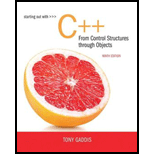
Concept explainers
Pointer:
Pointer, the name itself references the purpose of the pointer. Pointers point to a location in memory.
- Pointer is a special type of variable to store the address of the memory location, which can be accessed later.
- If an asterisk “*” operator is present before the variable, then that variable is referred as pointer variable.
- It is also called as dereferencing or indirection operator.
- Pointer is just a type of variable that stores the addresses of other variables.
- Using pointers, we can access the address of a variable; the data stored in that variable can be retrieved.
Syntax of pointer variable declaration:
<variable-type> *<variable-name>;
Example for pointer variable declaration:
//definition of pointer variable
int *ptrvar;
Where,
- int is the variable type.
- * ptrvar is the pointer variable name.
Pointer will allow the user to indirectly access and manipulate the data contents of the variable. A pointer variable will hold the address of the data contents.
Note:
- When the symbol “&” is placed prior the pointer variable, it will hold address of the pointer variable.
- When the symbol “*” is placed prior the pointer variable, it will hold the value of the pointer variable.
Purpose of “new” operator:
The main purpose of the “new” operator is to dynamically allocate memory. Dynamic memory allocation is process where an individual chunk of memory space is allocated by the compiler that is sufficient for the storage of variables. This kind of allocation is possible with pointer variables.
Example:
Consider a pointer variable of type integer needs to be allocated dynamically and it can be made possible using new operator as shown below:
//null pointer declaration
int *myptr = nullptr;
//dynamic allocation of memory
myptr = new int;
Want to see the full answer?
Check out a sample textbook solution
Chapter 9 Solutions
Starting Out with C++ from Control Structures to Objects Plus MyLab Programming with Pearson eText -- Access Card Package (9th Edition)
- Please solve and answer the questions correctly please. Thank you!!arrow_forwardConsidering the TM example of binary sum ( see attached)do the step-by-step of execution for the binary numbers 1101 and 11. Feel free to use the Formal Language Editor Tool to execute it; Write it down the current state of the tape (including the head position) and indicate the current state of the TM at each step.arrow_forwardI need help on inculding additonal code where I can can do the opposite code of MatLab, where the function of t that I enter becomes the result of F(t), in other words, turning the time-domain f(t) into the frequency-domain function F(s):arrow_forward
 EBK JAVA PROGRAMMINGComputer ScienceISBN:9781337671385Author:FARRELLPublisher:CENGAGE LEARNING - CONSIGNMENT
EBK JAVA PROGRAMMINGComputer ScienceISBN:9781337671385Author:FARRELLPublisher:CENGAGE LEARNING - CONSIGNMENT C++ Programming: From Problem Analysis to Program...Computer ScienceISBN:9781337102087Author:D. S. MalikPublisher:Cengage Learning
C++ Programming: From Problem Analysis to Program...Computer ScienceISBN:9781337102087Author:D. S. MalikPublisher:Cengage Learning New Perspectives on HTML5, CSS3, and JavaScriptComputer ScienceISBN:9781305503922Author:Patrick M. CareyPublisher:Cengage Learning
New Perspectives on HTML5, CSS3, and JavaScriptComputer ScienceISBN:9781305503922Author:Patrick M. CareyPublisher:Cengage Learning C++ for Engineers and ScientistsComputer ScienceISBN:9781133187844Author:Bronson, Gary J.Publisher:Course Technology Ptr
C++ for Engineers and ScientistsComputer ScienceISBN:9781133187844Author:Bronson, Gary J.Publisher:Course Technology Ptr Systems ArchitectureComputer ScienceISBN:9781305080195Author:Stephen D. BurdPublisher:Cengage Learning
Systems ArchitectureComputer ScienceISBN:9781305080195Author:Stephen D. BurdPublisher:Cengage Learning Programming with Microsoft Visual Basic 2017Computer ScienceISBN:9781337102124Author:Diane ZakPublisher:Cengage Learning
Programming with Microsoft Visual Basic 2017Computer ScienceISBN:9781337102124Author:Diane ZakPublisher:Cengage Learning





